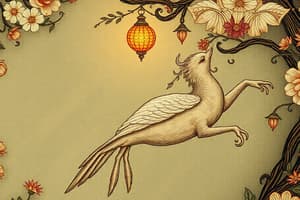Podcast
Questions and Answers
What is Poetry?
What is Poetry?
- A form of prose
- An ancient writing form that expresses thought in verse (correct)
- A type of painting
- A musical composition
What does Mood refer to in a poem?
What does Mood refer to in a poem?
The feeling or emotion created by a poem or story.
Hyperbole is a form of understatement used to create humor.
Hyperbole is a form of understatement used to create humor.
False (B)
Define Idiom.
Define Idiom.
What is Imagery?
What is Imagery?
What is Assonance?
What is Assonance?
What is a Stanza?
What is a Stanza?
What is Free Verse?
What is Free Verse?
Define Metaphor.
Define Metaphor.
What is a Simile?
What is a Simile?
What does Personification mean?
What does Personification mean?
What is a Symbol?
What is a Symbol?
Define Style in poetry.
Define Style in poetry.
What is Theme?
What is Theme?
What is Voice Inflection?
What is Voice Inflection?
Define Alliteration.
Define Alliteration.
What does Onomatopoeia mean?
What does Onomatopoeia mean?
What is Rhyme?
What is Rhyme?
Define Rhythm.
Define Rhythm.
What is a Poetic Element?
What is a Poetic Element?
What does Repetition mean?
What does Repetition mean?
Flashcards are hidden until you start studying
Study Notes
Poetry and Its Elements
- Poetry is an ancient writing form that conveys thoughts through verse.
- Mood refers to the emotional atmosphere created by a poem or story.
- Hyperbole is a deliberate exaggeration for emphasis or humor, e.g., "I'm so hungry, I could eat a horse."
- Idioms are expressions with meanings separate from their literal interpretations, such as "Shake a leg!" or "You let the cat out of the bag!"
Descriptive Language Techniques
- Imagery employs words or phrases that engage the five senses and create vivid mental pictures.
- Assonance involves the repetition of similar vowel sounds within a phrase.
- Alliteration features the repeated initial consonant sounds in a series of words, e.g., "Cows are craving cuisine crunch crops."
- Onomatopoeia refers to words that mimic sounds, like "plop," "buzz," and "snap."
Structure and Form
- A stanza is a structural unit of poetry or a section of a song, similar to a paragraph.
- Free verse poetry lacks a specific rhyme scheme or rhythmic pattern, allowing greater freedom of expression.
- Style encompasses the overall writing approach of a poem, including meter length, stanza count, and rhyme techniques.
Comparisons and Symbolism
- Metaphors compare two or more objects directly without using "like" or "as."
- Similes make comparisons between objects using the terms "like" or "as."
- Personification attributes human qualities or actions to non-human entities, including animals and abstract ideas.
- Symbols are tangible items that represent abstract concepts, such as a flag symbolizing national pride.
Themes and Repetition
- The theme encapsulates the underlying message, point of view, or central idea of a poem.
- Voice inflection involves changing the pitch or tone of voice to convey emotional emphasis.
- Rhythm represents the pattern of beats or stresses in language and contributes to the poem's mood.
- Repetition involves the recurrent use of words or phrases to emphasize particular ideas or themes.
Poetic Elements and Rhyme
- Poetic elements include various literary devices found within poetry, such as alliteration, metaphor, onomatopoeia, and rhythm.
- Rhyme is the repetition of similar sounds at the end of words, enhancing musical quality in poetry.
Studying That Suits You
Use AI to generate personalized quizzes and flashcards to suit your learning preferences.




